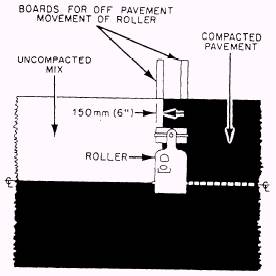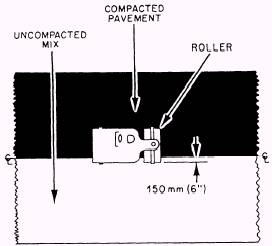|
BITUMINOUS ROLLING Most of the compaction required in bituminous construction is achieved by the tamper on the asphalt paver. Additional compaction and final surface texture are achieved by applying the rollers in the proper sequence. The hot mix should be at its optimum temperature for rolling when the rollers start to operate on the mat being laid. This optimum temperature should range between 225F to 285F. Rollers designed for bituminous operations are equipped with sprinklers that spray water on the smooth tires and drums. When you are rolling bituminous materials, the roller tires and drums must be moist with water to keep the bituminous materials from sticking. When water is not enough to keep the bituminous material from sticking, a non-foaming detergent is added to the water until the water has a soapy feeling. NOTE: Do NOT use a detergent that is designed to break down grease or oil, as this will break down the petroleum products used in the bituminous mix. NOTE: Ensure roller tires and drums are free of debris, such as sand, mud, dirt, and so forth, before rolling a hot bituminous mix. CAUTION Avoid prolonged skin contact with and inhalation of vapors from bituminous operations. When you are rolling bituminous materials, the rollers should move at a slow, uniform speed with the drive wheels positioned toward the paver. The speed should not exceed 3 mph for steel-wheeled rollers or 5 mph for pneumatic-tired rollers. Asphalt rollers must be kept in good condition and should be capable of being reversed without backlash. The line of rolling should not be suddenly changed or the direction of rolling suddenly reversed, thereby displacing the mix. Any pronounced change in direction should be made on stable material. Rolling hot bituminous mix is done in the following order: 1. Transverse joints 2. Longitudinal joints (when adjoining a previously placed lane) 3. Breakdown or initial rolling 4. Intermediate or second rolling 5. Finish rolling As a guide, longitudinal joint and edge rolling should be performed directly behind the paver; breakdown rolling less than 200 feet behind the paver; intermediate rolling 200 feet or more behind the breakdown rolling; and finish rolling as soon as possible behind the breakdown rolling. Transverse Joints When a transverse joint is placed next to an adjoining lane, the first pass is made with a steelwheeled roller moving along the longitudinal joint for a short distance. The surface is then straightedge and corrections made if necessary. The joint is then rolled transversely with all except 6 inches of the wheel width on the previously laid material (fig. 11-49). This operation should be repeated with successive passes

Figure 11-49.-Rolling a transverse joint. covering 6 to 8 inches of fresh material until the entire width of a roll is on the new mix. During transverse rolling, boards of proper thickness should be placed at the edge of the pavement to provide the roller a surface to drive on once it passes the edge of the hot bituminous mat. If boards are not used, the transverse rolling must stop 6 to 8 inches short of the outside edge in order to prevent damage to the edge. The outside edge then must be rolled out during longitudinal rolling. Longitudinal Joints Longitudinal joints should be rolled directly behind the paving operation, Only 4 to 6 inches of the roller width should ride on the newly placed mix (fig. 11-50). The rest of the roller should ride on the previously compacted side of the joint. With each subsequent pass, more and more of the roller width is placed on the mix until the entire width of the roller is on the newly placed mat. When rolling a longitudinal joint with a vibratory roller, the roller drum extends only 4 to 6 inches on the previously compacted lane with the rest of the drum width riding on the newly placed mat. The roller continues to roll along this line until a thoroughly compacted, neat joint is obtained. Longitudinal joints can be categorized as a hot or cold joint.

Figure 11-50.-Rolling a longitudinal joint. HOT JOINTS.- A hot joint is a joint between two lanes of bituminous mix placed at approximately the same time by pavers working in echelon. This type of laydown produces the best longitudinal joint, because both lanes are at, or near, the same temperature when rolled. The material compacts into a single mass under the roller, resulting with little or no difference in density between the two lanes. When you are paving in echelon, the breakdown roller following the lead paver leaves a 3- to 6-inch unrolled edge that the second paver follows. The second paver and roller should stay as close as possible to the first paver to ensure a uniform density is obtained across the joint. The roller following the second paver compacts the hot joint on its first pass (fig. 11-51). COLD JOINTS.- A cold joint is a joint between two lanes, one of which has cooled overnight or longer before the adjoining lane is placed. Because of the difference in temperature between the two lanes, there is a difference in density between the two sides of the joint. The longitudinal joint should be rolled directly behind the paver.
|

